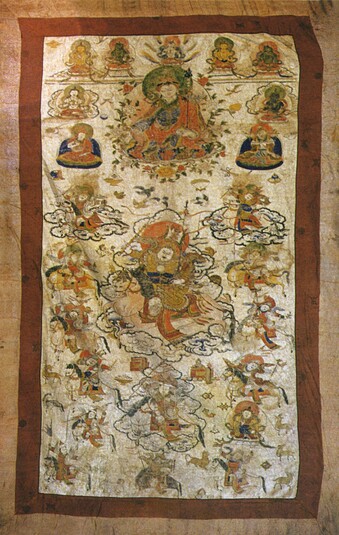
Item: King - Gesar
| Origin Location | Tibet |
|---|---|
| Date Range | 1900 - 1959 |
| Lineages | Nyingma and Buddhist |
| Material | Ground Mineral Pigment on Cotton |
| Collection | Private |
Classification: Person
Appearance: Warrior
Gender: Male
Ling Gesar along with retinue figures and Padmasambhava above.
Ling Gesar is depicted in the middle of the composition surrounded by fourteen retinue figures. All but one of the retinue figures is riding a horse and all appear like warriors similar to Gesar. The one odd figure not riding a horse is attired more in the appearance of a king or wealth deity, not a warrior, and he is seated in a relaxed manner.
In the upper portion of the composition is the seated form of Padmasambhava as the largest figure with Shantarakshita on the lower left, dressed as a monk, and King Trsiong Detsen on the lower right, dressed as a king. At the top center, above Padmasambhava is the white form of Vajrasattva. Accompanying those identified figures are six additional peaceful deities, possibly the Five Symbolic Buddhas with one extra. They each hold an attribute in the right hand and have a body colour of white, blue, two green and two yellow.
The image shown above was first seen in a Chinese language publication on the life story of Ling Gesar (published approximately 2003). Based on the iconography and context there is really no doubt as to the identity. It is interesting to compare this image with another painting in the collection of the Sichuan University. That image, although not yet on the HAR website, is similar in appearance to the image above. Both paintings appear to be drawn and painted on either a very thin ground or no ground at all. The background and over-all colour palette are very similar. The hand is different, along with the strokes and sense of composition, yet the ground and palette remain similar.
Jeff Watt 11-2011
King: Gesar Norbu Dradul
King: Gesar Main Page
